View in other NatureServe Network Field Guides
NatureServe
Montana
Utah
Wyoming
Idaho
Wisconsin
British Columbia
South Carolina
Yukon
California
New York
Robust Lancetooth - Haplotrema vancouverense
Other Names:
Helix vancouverensis, Helix vellicata, Macrocyclis vancouverensis, Circinaria vancouverensis
General Description
A relatively large shell, diameter 20-30 mm and height 8-12 mm. The chitonous or horny shell is a flattened heliciform of up to 5 1/2 whorls, the final portion expanded near the lip, the aperture lip slightly thickened, with the upper margin slightly down-turned. The shell is dull to slightly shiny, yellow to olive-green with low wrinkles and microscopic spiral striae, sometimes with streaks, but no spiral bands. Head, neck, and body are creamy white, the tentacles darker (pale bluish) (Hendricks 2012, Burke 2013). Internal anatomy is described by Pilsbry (1946).
A dark-brown form, H. v. chocolata, described from Alaska and appearing also in western Oregon and Washington, appears to be a color variant within typically-colored populations.
Diagnostic Characteristics
A combination of large size, flattened spire, and an unbanded yellowish to greenish shell are unique in Montana, as is the strikingly creamy-white coloration of the live animal.
Species Range
Montana Range
Range Descriptions

 Native
Native
Range Comments
Aleutian Islands and coastal Alaska south to northwestern California, east to northern Idaho and northwestern Montana (Burke 2013). In Montana, 11 records in two counties west of the Continental Divide: Lincoln (5), Sanders (6). Elevation range is 664 to 1140 m (2180 to 3740 ft). The Idaho and Montana populations may be isolated from the main coastal range of the species. First reported from Montana in 1956 (Brunson and Osher 1957); not reported again until 2006. As many as nine individuals were found at two sites in Lincoln County in mid-October (Hendricks 2012).
Observations in Montana Natural Heritage Program Database
Number of Observations: 11
(Click on the following maps and charts to see full sized version)
Map Help and Descriptions
Relative Density
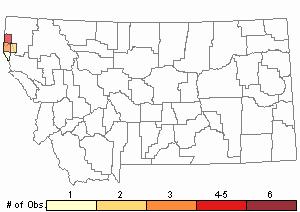
Recency
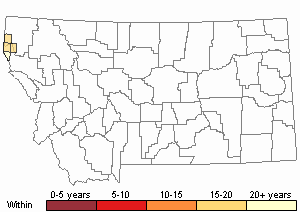
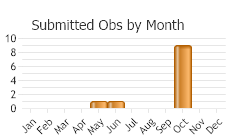
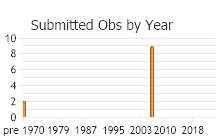
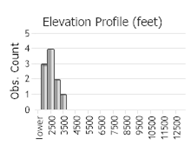 (Observations spanning multiple months or years are excluded from time charts)
(Observations spanning multiple months or years are excluded from time charts)
Habitat
Mostly in mesic mixed conifer forest, typically near water such as stream-side riparian, seeps and wetlands, sometimes near areas of human activity such as campgrounds. Canopy species include western redcedar, western hemlock, grand fir, Douglas-fir, black cottonwood, paper birch, and a secondary canopy including aspen and alder. Found in leaf litter, under woody debris, rocks, and bryophyte mats (Forsyth 2004, Hendricks 2012).
References
- Literature Cited AboveLegend:
 View Online Publication
View Online Publication Brunson, R.B., and U. Osher. 1957. Haplotrema from western Montana. Nautilus 70: 121-123.
Brunson, R.B., and U. Osher. 1957. Haplotrema from western Montana. Nautilus 70: 121-123. Burke, T. E. 2013. Land snails and slugs of the Pacific Northwest. Corvallis, OR: Oregon State University Press. 344 p.
Burke, T. E. 2013. Land snails and slugs of the Pacific Northwest. Corvallis, OR: Oregon State University Press. 344 p. Forsyth, R.G. 2004. Land snails of British Columbia. Royal British Columbia Museum: Victoria, British Columbia, Canada. 188 pp.
Forsyth, R.G. 2004. Land snails of British Columbia. Royal British Columbia Museum: Victoria, British Columbia, Canada. 188 pp. Hendricks, P. 2012. A Guide to the Land Snails and Slugs of Montana. A report to the U.S. Forest Service - Region 1. Montana Natural Heritage Program, Helena, MT. vii + 187 pp. plus appendices.
Hendricks, P. 2012. A Guide to the Land Snails and Slugs of Montana. A report to the U.S. Forest Service - Region 1. Montana Natural Heritage Program, Helena, MT. vii + 187 pp. plus appendices. Pilsbry, H.A. 1946. Land Mollusca of North America (north of Mexico), Volume II Part 1. Academy of Natural Sciences of Philadelphia Monograph Number 3 (2):1-520.
Pilsbry, H.A. 1946. Land Mollusca of North America (north of Mexico), Volume II Part 1. Academy of Natural Sciences of Philadelphia Monograph Number 3 (2):1-520.
- Additional ReferencesLegend:
 View Online Publication
View Online Publication
Do you know of a citation we're missing? Bland, T. and J.G. Cooper. 1861. Notice of land and freshwater shells collected by Dr. J.G. Cooper in the Rocky Mountains, etc, in 1860. Annals of the Lyceum of Natural History of New York 7:362-370.
Bland, T. and J.G. Cooper. 1861. Notice of land and freshwater shells collected by Dr. J.G. Cooper in the Rocky Mountains, etc, in 1860. Annals of the Lyceum of Natural History of New York 7:362-370. Frest, T.J. and E.J. Johannes. 2001. An annotated checklist of Idaho land and freshwater mollusks. Journal of the Idaho Academy of Science 36(2):1-51.
Frest, T.J. and E.J. Johannes. 2001. An annotated checklist of Idaho land and freshwater mollusks. Journal of the Idaho Academy of Science 36(2):1-51. Hendricks, P., B.A. Maxell, and S. Lenard. 2006. Land mollusk surveys on USFS Northern Region lands. A report to the USDA Forest Service, Northern Region. Montana Natural Heritage Program, Helena, Montana. 11 pp. plus appendices.
Hendricks, P., B.A. Maxell, and S. Lenard. 2006. Land mollusk surveys on USFS Northern Region lands. A report to the USDA Forest Service, Northern Region. Montana Natural Heritage Program, Helena, Montana. 11 pp. plus appendices. Hendricks, P., B.A. Maxell, S. Lenard, and C. Currier. 2007. Land mollusk surveys on USFS Northern Region lands: 2006. A report to the USDA Forest Service, Northern Region. Montana Natural Heritage Program, Helena, Montana. 11 pp. plus appendices.
Hendricks, P., B.A. Maxell, S. Lenard, and C. Currier. 2007. Land mollusk surveys on USFS Northern Region lands: 2006. A report to the USDA Forest Service, Northern Region. Montana Natural Heritage Program, Helena, Montana. 11 pp. plus appendices.
- Web Search Engines for Articles on "Robust Lancetooth"
- Additional Sources of Information Related to "Snails / Slugs"





